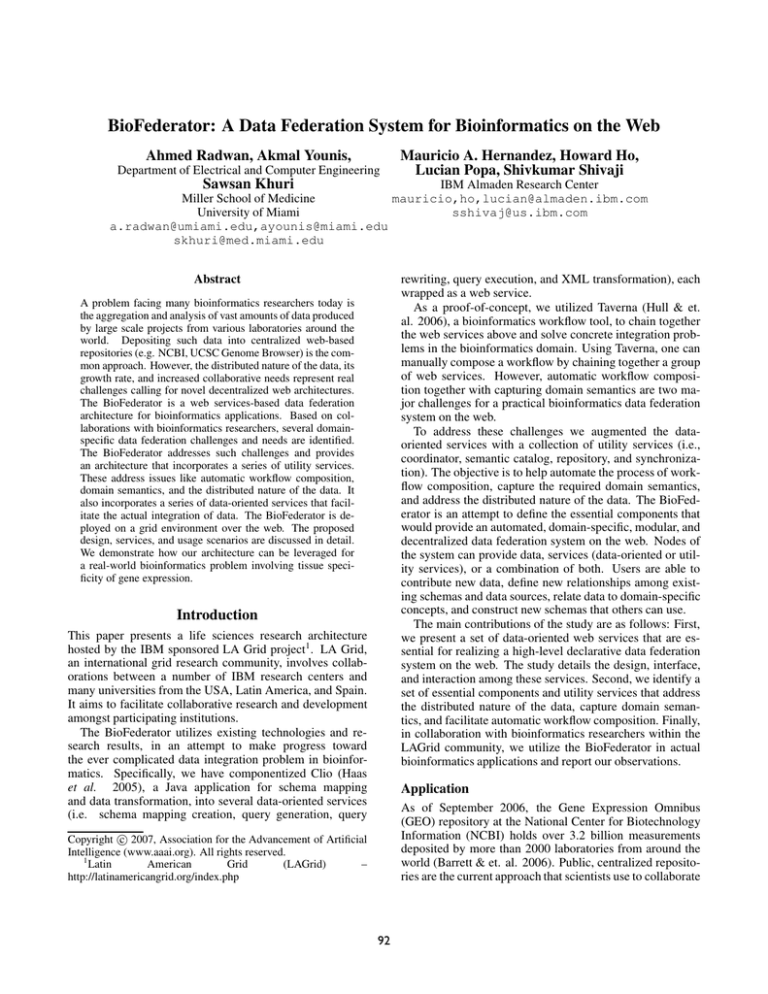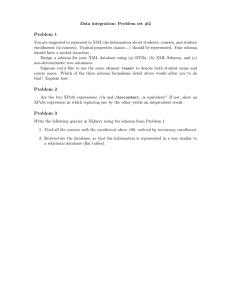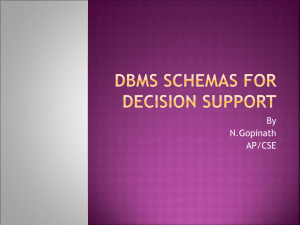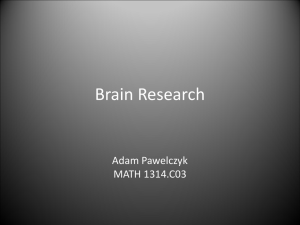
BioFederator: A Data Federation System for Bioinformatics on the Web
Ahmed Radwan, Akmal Younis,
Department of Electrical and Computer Engineering
Mauricio A. Hernandez, Howard Ho,
Lucian Popa, Shivkumar Shivaji
Sawsan Khuri
IBM Almaden Research Center
mauricio,ho,lucian@almaden.ibm.com
Miller School of Medicine
sshivaj@us.ibm.com
University of Miami
a.radwan@umiami.edu,ayounis@miami.edu
skhuri@med.miami.edu
rewriting, query execution, and XML transformation), each
wrapped as a web service.
As a proof-of-concept, we utilized Taverna (Hull & et.
al. 2006), a bioinformatics workflow tool, to chain together
the web services above and solve concrete integration problems in the bioinformatics domain. Using Taverna, one can
manually compose a workflow by chaining together a group
of web services. However, automatic workflow composition together with capturing domain semantics are two major challenges for a practical bioinformatics data federation
system on the web.
To address these challenges we augmented the dataoriented services with a collection of utility services (i.e.,
coordinator, semantic catalog, repository, and synchronization). The objective is to help automate the process of workflow composition, capture the required domain semantics,
and address the distributed nature of the data. The BioFederator is an attempt to define the essential components that
would provide an automated, domain-specific, modular, and
decentralized data federation system on the web. Nodes of
the system can provide data, services (data-oriented or utility services), or a combination of both. Users are able to
contribute new data, define new relationships among existing schemas and data sources, relate data to domain-specific
concepts, and construct new schemas that others can use.
The main contributions of the study are as follows: First,
we present a set of data-oriented web services that are essential for realizing a high-level declarative data federation
system on the web. The study details the design, interface,
and interaction among these services. Second, we identify a
set of essential components and utility services that address
the distributed nature of the data, capture domain semantics, and facilitate automatic workflow composition. Finally,
in collaboration with bioinformatics researchers within the
LAGrid community, we utilize the BioFederator in actual
bioinformatics applications and report our observations.
Abstract
A problem facing many bioinformatics researchers today is
the aggregation and analysis of vast amounts of data produced
by large scale projects from various laboratories around the
world. Depositing such data into centralized web-based
repositories (e.g. NCBI, UCSC Genome Browser) is the common approach. However, the distributed nature of the data, its
growth rate, and increased collaborative needs represent real
challenges calling for novel decentralized web architectures.
The BioFederator is a web services-based data federation
architecture for bioinformatics applications. Based on collaborations with bioinformatics researchers, several domainspecific data federation challenges and needs are identified.
The BioFederator addresses such challenges and provides
an architecture that incorporates a series of utility services.
These address issues like automatic workflow composition,
domain semantics, and the distributed nature of the data. It
also incorporates a series of data-oriented services that facilitate the actual integration of data. The BioFederator is deployed on a grid environment over the web. The proposed
design, services, and usage scenarios are discussed in detail.
We demonstrate how our architecture can be leveraged for
a real-world bioinformatics problem involving tissue specificity of gene expression.
Introduction
This paper presents a life sciences research architecture
hosted by the IBM sponsored LA Grid project1 . LA Grid,
an international grid research community, involves collaborations between a number of IBM research centers and
many universities from the USA, Latin America, and Spain.
It aims to facilitate collaborative research and development
amongst participating institutions.
The BioFederator utilizes existing technologies and research results, in an attempt to make progress toward
the ever complicated data integration problem in bioinformatics. Specifically, we have componentized Clio (Haas
et al. 2005), a Java application for schema mapping
and data transformation, into several data-oriented services
(i.e. schema mapping creation, query generation, query
Application
As of September 2006, the Gene Expression Omnibus
(GEO) repository at the National Center for Biotechnology
Information (NCBI) holds over 3.2 billion measurements
deposited by more than 2000 laboratories from around the
world (Barrett & et. al. 2006). Public, centralized repositories are the current approach that scientists use to collaborate
c 2007, Association for the Advancement of Artificial
Copyright Intelligence (www.aaai.org). All rights reserved.
1
Latin
American
Grid
(LAGrid)
–
http://latinamericangrid.org/index.php
92
and share their data on a global level.
Centralized repositories like the GEO or the UCSC
Genome Browser (Kent et al. 2002) for example, are in
fact only partially serving these collaborative needs. Bioinformatics is a multidisciplinary field, and as such, scientists
from different communities may require a customized view
or organization of data. For example, a specific schema definition may be suitable for a computer scientist. However,
a biologist may be more comfortable with a different organization of the data. Moreover, the capabilities of relating
such views, dynamic sharing, and evolution of data are challenges calling for novel web architectures. The BioFederator is an attempt to address these challenges. It aims to
transform public centralized web repositories into a decentralized one that could dynamically evolve, while providing
more services. Groups of scientists can dynamically define
new schemas, populate these schemas with data, update existing schemas/data, and define relationships between existing schemas/data that others can use.
The BioFederator team involves collaborators from
biomedical and genetics domains. The objective of the collaboration is to better understand domain-specific problems
and needs, and to ensure that realistic bioinformatics scenarios are addressed. A number of bioinformatics studies illustrate the need for integrating data from multiple sources.
The study in (Shaker et al. 2004) mentions some examples.
Pharmacogenomics is yet another example of an emerging
arena with increasing computational needs. Pharmacogenomics deals with the influence of inherent genetic variation on drug responses in patients, promising the advent of
“personalized medicine” in which drugs and drug combinations are optimized for each individual’s unique genetic
makeup. To make such “personalized” medical decisions,
information from multiple heterogeneous data sources needs
to be retrieved and analyzed in a quick, user-friendly fashion. The databases that are currently available that house
pieces of this information puzzle are diverse: for example, OMIM (McKusick 1998) and dbSNP (Smigielski et al.
2000) from NCBI, the TRANSFAC database from BioBase
(Kel-Margoulis & et. al. 2005), and PharmGKB (Klein &
et. al. 2001).
Figure 1 shows a hypothetical study that aims to understand the rate of gene expression in different tissues, and to
correlate these expression profiles with active transcription
factors and their binding sites. The data required for this
study is distributed among multiple heterogenous sources
(e.g., UCSC Genome Browser, GNF SymAtlas (Su & et. al.
2002), and TRANSFAC). The figure shows how Clio mapping technology can be used to provide a high-level definition for mappings between the source and target schemas. In
particular, a graphical user interface allows entering correspondences that relate schema elements. The schema mapping creation service takes the correspondences as input and
computes a more precise mapping specification based on the
schema information and constraints. This mapping specification can subsequently be used by other services. More details on the specific data services are provided in the Architecture and Services section, and this figure will be revisited
in more detail in the Usage Scenarios section.
Figure 1: High-level mapping definition using Clio
It should be noted that the BioFederator focuses on bioinformatics data integration applications. However, a typical
bioinformatics research project involves both computational
and data driven aspects. While data driven processes may
extract data from various sources, the computational processes would process the data through algorithms for pattern
matching, sequence alignment, and clustering. A computational architecture and associated services for the bioinformatics domain is under investigation.
Related Work
A number of data integration systems have been proposed
to address the problem of large-scale data sharing, e.g.,
(Garcia-Molina & et. al. 1997), (Duschka & Genesereth
1997), (Manolescu, Florescu, & Kossmann 2001), and the
survey by Halevy (Halevy 2001)). These systems support
rich queries over large numbers of autonomous, heterogeneous data sources by making use of semantic relationships between the different source schemas and a mediated
schema, that is designed globally. However, the mediated
schema itself becomes a problem. First, it may be hard to
come up with a single mediated schema which everyone
agrees with. Second, all the access (querying) is done via
a single point (the mediated schema). Furthermore, this architecture is not robust with respect to changes in the source
schemas. As a result, data integration systems based on
mediated schemas are limited in supporting large-scale distributed and autonomous data sharing.
Peer Data Management Systems (PDMS), e.g., Piazza in
(Halevy et al. 2004), have been proposed to address the
aforementioned problems and to offer an extensible and decentralized data sharing system. The BioFederator’s requirements are, in principle, no different from these peer data
management systems. Compared to Piazza, our intended applications imply smaller numbers of data sources. However,
the sources have complex schemas and may contain overlapping and potentially conflicting and dynamically changing data. BioFederator emphasizes the use of tools and services that facilitate mappings among schemas and generate
93
coordinator can make a decision on handling the request,
i.e., forward, split, or directly handle.
The coordinator maintains a set of rules to help make such
decisions. The efficiency and accuracy in defining such rules
is crucial for correct and efficient system performance. The
rules are a function of the quality of service, load balancing, and optimization requirements. While a system could
function well using limited rules, its performance could be
enhanced by adding and tuning rules. For example, a simple rule is to forward the request to the first node that has
the required services deployed. However, a better rule is to
incorporate the location of the data. From our experience,
fine tuning rules may result in complex but efficient workflows of services. Policies like query distribution and data
materialization are initiated by the coordinator service.
Semantic Catalog: This service provides a domainspecific organization of the data. Figure 3 depicts the structure of an illustrative subset of the semantic catalog. The
BioFederator does not require a fixed structure for the semantic catalog. In fact, different structures could arise
based on application needs and it can dynamically evolve
over time. The structure used and illustrated in Figure 3
is inspired by the one utilized at the UCSC Genome Table
Browser2 .
The semantic catalog in Figure 3 is organized as a set of
topics in a tree structure; the root node is the most general
topic, i.e., the whole catalog, while leaf nodes represent the
most specific topics, i.e., schema definitions. Topics are labeled and each has an associated unique identifier, TID. This
can be evaluated by traversing the tree starting from the root,
the root topic has TID=0. The depicted dark route in the figure highlights the path traversed to evaluate the TID for the
“Expression/Regulation” topic (TID=0.2.2.1.2).
The tree structure facilitates an XML representation of
the catalog with the associated query mechanisms, and a
synchronization mechanism based on WSRF3 notification.
However, other structures could be used if the appropriate
query and synchronization mechanisms are provided.
Topics play an important role in the devised notification
mechanism (discussed later in the synchronization service).
Every node in the proposed architecture defines its own set
of “topics of interest”. Individual topics are only replicated
on nodes that identify them as “topics of interest”. That is,
the system does not replicate the entire catalog on all nodes.
This technique has three advantages: 1) It limits the size of
the semantic catalog on specific nodes, 2) Topics can help
large systems define specialized clusters of nodes, and 3) It
helps preserve autonomy of nodes (each node has full control of the contents of it’s local catalog). Note that, if all
nodes identify the entire catalog (TID=0) as a topic of interest, then the full catalog will be replicated on all nodes.
Figure 3 illustrates the distributed data repository and
depicts how semantic catalog topics are linked to data resources stored there. Leaf topics represent schema definitions, and they can point (using URIs4 ) to one or more data
Figure 2: BioFederator nodes architecture
the queries that are needed to access and integrate the data.
In many respects our vision is similar in spirit to that of the
SHARQ project (Taylor & Ives 2006).
Architecture and Services
The system is built from a collection of nodes, a node can
be any device or computer having the required web services
deployed. Nodes can be dynamically added or removed, and
the system adapts to deliver quality of service requirements.
Figure 2 depicts the architecture of typical BioFederator nodes. Each node contains six components/services,
namely: the coordinator service, the semantic catalog, the
repository service, a local data repository, the synchronization service, and the data services suite. To support system portability, all components and services are built using
Java and XML. The proposed system architecture supports
distributed storage and manipulation of data. One or more
application servers can connect users to the BioFederator.
The application server can initiate multiple concurrent requests (by contacting multiple nodes). However, for every
request, the application server designates a particular node
as the “master” node. Any node is capable of performing
the “master” role. The master can distribute the required operations among many other nodes and is also responsible for
coordinating, collecting, and merging results from “slave”
nodes.
Coordinator Service: This service is the front-end interaction point for a given BioFederator node. It maintains
a list of all registered nodes in the whole system, in addition to locally and remotely deployed services. It can access the metadata maintained in the local semantic catalog
(discussed later in detail). Coordinator services are key elements for automated workflow construction because they are
responsible for decisions involving forwarding, splitting, or
directly handling a received request.
Upon receiving a request, the coordinator needs to access the semantic catalog to retrieve information about data
needed/involved in the request. Based on metadata and information about registered nodes and deployed services, the
2
http://genome.ucsc.edu/cgi-bin/hgTables
http://www.globus.org/wsrf/
4
Uniform Resource Identifiers
3
94
for accessing different file systems and presents a unified
view of files from different sources (e.g., local disk, remote
ftp, or http servers). The repository service is responsible
for storing and extracting all raw data (via the VFS). It also
notifies the synchronization service if there are any changes
to the local repository. In the current implementation, only
a pure XML data repository is supported. Other data representations can be supported if the data can be exported as
XML.
Synchronization Service: This service keeps the local semantic catalog entries synchronized with other nodes.
When a node is added, it has the option of subscribing to
various topics. Whenever a change occurs in the semantic
catalog (of one node) affecting a certain topic, nodes that are
subscribing to that topic receive notifications of the update.
This service is implemented on top of the WSRF notification
mechanism provided by the Globus Toolkit.
Data Services Suite: This component provides a number
of web services that allow the creation of schema mappings
and operations using those schema mappings. We have selected Clio’s (Haas et al. 2005) schema mapping components, and wrapped them into web services. The suite provides the following data services:
Figure 3: The semantic catalog structure and relation with
data repository elements
• Schema Mapping Creation: Given a source and a target
schema, and a set of “correspondences” between source
and target schema elements, this service creates a “mapping” from the source to the target schema. This mapping consists of a set of declarative constraints that dictate what the target instance should be, given a source
instance. The mapping creation algorithm takes into account the schema constraints, e.g., foreign key constraints
and type constraints, as well as the correspondences (Popa
et al. 2002).
resources. A basic URI is needed to point to the schema definition (XSD) file, and additional URIs can point to one or
more instances of this definition, i.e., XML files. In addition,
pointers to schema mapping files that directly relate pairs of
schemas can be specified. Such mappings, created by the
schema mapping creation service described later, specify the
exact semantics of data conversion from one schema to another, and can be subsequently used by other data services.
Two kinds of schema topics are identified in the semantic catalog illustrated in Figure 3, specifically the schema
and the concepts schema. A schema follows the conventional definition while a concept schema is created by mapping schema elements to concept unique identifiers (CUIs)
from a specific conceptual model, e.g., using the UMLSKS5
Metathesaurus. For example, a schema element representing a gene identifier can be named geneID in one schema
and gID in another, however both will be mapped to the
same UMLSKS CUI: C1706509. Typically, the conventional schema and its corresponding concepts schema exhibit the same structure. Mutual correspondences between
conventional and concept schemas are stored in the semantic catalog. Concept schemas can be useful for deriving relations between different schema definitions, e.g., to discover
if a given schema is equivalent, a superset, or a subset of an
existing one.
Repository Service and the Data Repository: Currently, this service is implemented on top of the Apache
Commons Virtual File System (VFS)6 . VFS provides APIs
• Query Generation: Given a mapping produced by the
Schema Mapping Creation service, this service generates
an XQuery, XSLT, or a SQL/XML query that implements
the transformation implied by the mapping (Haas et al.
2005). The query and its associated mapping are stored in
the semantic catalog, potentially for further reuse.
• Query Execution: For convenience, we also have a service that executes the queries generated by the previous
service. Given a query script and a set of input XML documents (instances of the source XML schema used in the
mapping, for example), the service executes the query and
returns the resulting XML document.
• XML Transformation: We also provide a service that allows the direct and scalable execution of the mapping, as
opposed to simply executing the query that implements it.
Based on the technology detailed in (Jiang et al. 2007),
this service takes as input a mapping and the source XML
instances and returns the target XML instance that is implied by the mapping. As opposed to the Query Generation or Execution services, this service neither produces
nor executes a query; rather, this service uses a Java based
engine that optimally executes the mapping.
5
Unified Medical Language System Knowledge Source Server,
http://umlsks.nlm.nih.gov
6
http://jakarta.apache.org/commons/vfs/
• Query Rewrite: An interesting application of mappings
is the ability to rewrite (or translate) target-side queries
95
into queries that work on the source-side. This is useful,
for example, if the target side schemas are virtual and the
actual data resides on the source side. We use the query
rewriting techniques detailed in (Yu & Popa 2004) to implement this service. Given a schema mapping and an
XQuery over a target schema instance, this service returns
a rewritten XQuery over the source schemas in the mapping. When the rewritten XQuery is executed against the
data source instance, the resulting data has the same structure as the intended output of the original target XQuery.
unique identifiers, can be provided to help construct the corresponding concepts schema.
Having the schemas and actual data, the USA team connects to their node via an application server and starts uploading their data. The coordinator service delegates the
repository service which handles the storage process (via
VFS) and notifies the synchronization service to update the
local semantic catalog. Figure 3 shows the uploaded schema
Known Gene topic pointing to the schema definition file and
actual instances on the USA node. The synchronization service also notifies remote synchronization services, which are
subscribed to the topic associated with the newly uploaded
data. Note that the coordinator service may decide to store
data on multiple nodes based on quality of service requirements. Figure 3 shows an additional instance saved on the
Spain node.
Schema Mapping: Assume now that the teams in Spain
and Mexico have also uploaded their data. Thus, all three
data sources have been loaded with data, which is hosted on
different nodes. Now the analysis team in the UK can start
interpreting and analyzing the data deposited by the other
three groups. However, they are facing the problem of how
to merge and integrate this data. They realize that in order
to efficiently analyze the data, they would like to organize
it according to a specific structure. Therefore, the UK team
constructs a new schema that captures the required data organization (the target schema in Figure 1).
The BioFederator includes a powerful schema mapping
component that can create the mappings from the source
schemas into the new target schema. The UK team connects
and downloads (via Java Web Start) an application that allows the construction of Clio-based mappings. Source and
target schemas are loaded into the tool which shows their
structure as a tree of schema elements (very similar to how
they are presented in Figure 1). Value mappings are entered by drawing lines from source schema elements to target schema elements. The schema mapping creation service processes the mapping specification and passes it to the
repository service for storage. The synchronization service
updates the local semantic catalog and notifies remote nodes
about the new mapping. Figure 3 shows the target schema
“Gene Tissues scores” pointing to both the schema definition file and the mappings file on the repository (UK node).
When a decision is taken to construct a materialized instance
of the target schema, the mappings specifications file is read
and the source schemas TIDs are extracted.
Query Processing: After constructing the new, federated
target schema in the previous step, various analysis groups
can start accessing and querying it.
Different query processing scenarios could arise based on
the location of data (which can be either locally or remotely
stored), and whether the query is against a materialized version of the data or not. If the data is not materialized then either a materialization or a query distribution decision could
be made by the coordinator service. Criteria for this decision can be based on the frequency of the queries against the
data sources, and it can be locally materialized if the number
of queries received exceeds a specific threshold.
For instance, imagine that the UK team is trying to answer
• Schema Integration: Given a number of mappings between several schemas, this service attempts to create an
“integrated” schema that captures the unified concepts of
the schemas that are related by the mapping7 (Chiticariu,
Kolaitis, & Popa 2007). For example, given a mapping
between two schemas S1 and S2, this service creates a
new schema T that integrates the concepts in S1 and S2.
This can eliminate the need to manually construct such
target schema.
Usage Scenarios
We present an example of a collaborative scenario that
can be achieved using the BioFederator. To simulate this
scenario, schemas and data were downloaded from public
repositories, and were then stored on various BioFederator
nodes. The hypothetical scenario involves three collaborating groups of scientists. Assume that the groups are associated with the three data sources shown in Figure 1, and are
located in the USA, Spain, and Mexico respectively. The
group based in the USA is conducting experiments related
to the identification of known genes, their chromosomal positions, and so on. The team in Spain is investigating gene
expression levels in different tissues, while Mexican team
is concerned with the identification of transcription factor
binding sites that are active on different genes, and the associated transcription factors. Furthermore assume that there
is a fourth team in the UK that will do the analysis of the collected data. Their role is to collect and interpret data from
different teams and to discover new knowledge from the experiments.
Initialization: Each site in the study independently sets up
and configures its own node. The configuration process includes the installation of any required software and the deployment of required services. As nodes join the system,
their coordinator services update lists of registered nodes,
deployed services (both local and remote), and subscribe to
the “topics of interest”.
Data Storage: Assume that the group in the USA has collected data that needs to be deposited into the system. The
first step is to define a suitable schema to represent this data,
if one is not already available. The next step is to prepare
the actual data instance conforming to the designed schema
and choose the associated parent topic (the topic should be
identified in the hierarchy of topics in the semantic catalog).
Optionally, mapping from schema elements to CUI, concept
7
The service currently provides a ranked list of possible integrated schemas for the user to choose from.
96
Jiang, H.; Ho, H.; Popa, L.; and Han, W.-S. 2007.
Mapping-Driven XML Transformation. In 16th International World Wide Web Conference.
Kel-Margoulis, O., and et. al. 2005. Information Processing and Living Systems:Databases on Gene Regulation.
Imperial College Press, London.
Kent, W.; Sugnet, C.; Furey, T.; Roskin, K.; Pringle, T.;
Zahler, A.; and Haussler, D. 2002. The Human Genome
Browser at UCSC. Genome Research 12(6):996–1006.
Klein, T., and et. al. 2001. Integrating Genotype and
Phenotype Information: An Overview of the PharmGKB
Project. The Pharmacogenomics Journal 1:167–170.
Manolescu, I.; Florescu, D.; and Kossmann, D. 2001. Answering XML Queries on Heterogeneous Data Sources. In
VLDB, 241–250.
McKusick, V. 1998. Mendelian Inheritance in Man. A Catalog of Human Genes and Genetic Disorders. Baltimore:
Johns Hopkins University Press.
Popa, L.; Velegrakis, Y.; Miller, R. J.; Hernández, M. A.;
and Fagin, R. 2002. Translating Web Data. In VLDB,
598–609.
Shaker, R.; Mork, P.; Brockenbrough, J. S.; Donelson, L.;
and Tarczy-Hornoch, P. 2004. The BioMediator System as
a Tool for Integrating Biologic Databases on the Web. In
Proceedings of the Workshop on Information Integration
on the Web.
Smigielski, E. M.; Sirotkin, K.; Ward, M.; and Sherry, S. T.
2000. dbSNP: a database of single nucleotide polymorphisms. Nucleic Acids Research 28(1):352–355.
Su, A., and et. al. 2002. Large-scale analysis of the human and mouse transcriptomes. In National Academy of
Sciences of the United States of America.
Taylor, N., and Ives, Z. 2006. Reconciling while tolerating
disagreement in collaborative data sharing. In SIGMOD,
13–24.
Yu, C., and Popa, L. 2004. Constraint-Based XML Query
Rewriting for Data Integration. In SIGMOD, 371–382.
the following query using the federated target schema:
Find a list of genes names and their chromosomal locations having an expression level ≥ e in both heart
and liver, and that are regulated by the same set of
transcription factors.
The above query is written against the federated target
schema. However, the UK node does not have any data associated with this federated schema, i.e., all data resides at
the other nodes (a Global-Local-As-View (GLAV) scenario
(Friedman, Levy, & Millstein. 1999)). One alternative could
be data materialization, i.e., creating an instance of the target schema, using query generation and execution services,
and then executing the query against this instance. Another
alternative is using the query rewrite service as discussed
above.
Conclusion and Future Work
This paper introduces the BioFederator, a web servicesbased data federation system. The data-oriented services offer high-level data mapping and transformation capabilities
while the utility services address the distributed nature of
the data, capture domain semantics, and automate the workflow composition process. The presented architecture represents a novel, modular, and decentralized method to realize
web based bioinformatics repositories. We are planning to
extend the current pilot implementation by involving more
bioinformatics research groups and scenarios to identify the
capabilities, limitations, and potential future developments.
References
Barrett, T., and et. al. 2006. NCBI GEO: mining tens of
millions of expression profiles database and tools update.
Nucleic Acids Research 35:D760–D765.
Chiticariu, L.; Kolaitis, P. G.; and Popa, L. 2007. SemiAutomatic Generation and Exploration of Schema Integration Alternatives. Submitted for publication.
Duschka, O. M., and Genesereth, M. R. 1997. Answering
recursive queries using views. In PODS, 109–116.
Friedman, M.; Levy, A.; and Millstein., T. 1999. Navigational plans for data integration. In 16th National Conference on Artificial Intelligence (AAAI).
Garcia-Molina, H., and et. al. 1997. The TSIMMIS Approach to Mediation: Data Models and Languages. Journal
of Intelligent Information Systems 8(2):117–132.
Haas, L. M.; Hernández, M. A.; Ho, H.; Popa, L.; and
Roth, M. 2005. Clio Grows Up: From Research Prototype
to Industrial Tool. In SIGMOD, 805–810.
Halevy, A. Y.; Ives, Z. G.; Madhavan, J.; Mork, P.; Suciu,
D.; and Tatarinov, I. 2004. The Piazza Peer Data Management System. IEEE Trans. Knowl. Data Eng. 16(7):787–
798.
Halevy, A. 2001. Answering Queries Using Views: A
Survey. VLDB Journal 270–294.
Hull, D., and et. al. 2006. Taverna, A tool for building
and running workflows of services. Nucleic Acids Research
34:w729–w732.
97







